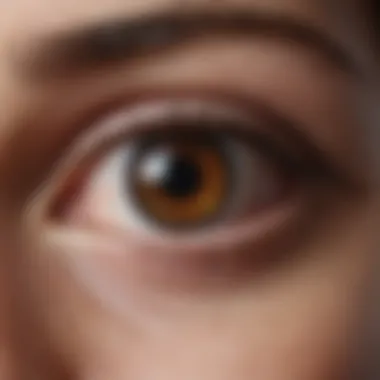Understanding Eye Lesions: Causes and Treatments


Intro
Eye lesions represent a significant area of concern within ophthalmology. Ranging from benign to malignant, these lesions can greatly impact visual health and daily life. As advancements in medical research continue, understanding the complexities of eye lesions becomes increasingly vital. This article will delve into the multifaceted nature of eye lesions, discussing their types, causes, clinical presentations, diagnostic approaches, and treatment modalities.
Throughout this exploration, we will examine how eye lesions correlate with broader health issues and the importance of early detection and intervention. By unpacking the various dimensions of eye lesions, we aim to inform students, researchers, educators, and professionals, enhancing their comprehension of this critical subject.
Let us proceed by discussing the research overview on eye lesions.
Preamble to Eye Lesions
Eye lesions represent a significant aspect of ocular health that can have profound implications on visual function and quality of life. Understanding eye lesions is critical for both preventive care and effective management strategies. These lesions can manifest in various forms, ranging from benign abnormalities to serious conditions that may threaten eyesight. This sections highlights the need for a comprehensive grasp of the subject, noting how lesions can arise from diverse causes, such as infections, trauma, or underlying diseases.
The healthy eye is crucial for various day-to-day activities, and any lesion can impact not just sight but also a person's overall well-being. When patients or practitioners recognize the signs of potential eye lesions early, timely intervention can often prevent more severe complications. Thus, recognizing and comprehending the nature of eye lesions is not only important for healthcare professionals but also for anyone with an interest in maintaining eye health.
Defining Eye Lesions
Eye lesions are abnormal changes in the structure of the eye, commonly observable in the iris, cornea, conjunctiva, retina, or other ocular tissues. These lesions can result from a variety of factors, including infections, inflammation, or even neoplasms. In a clinical context, understanding the specific characteristics of a lesion – whether it is pigmented or non-pigmented, flat or raised, for instance – is essential for diagnosis and treatment planning. Each lesion presents unique features, which contribute to the challenges of accurately identifying their nature.
Epidemiology of Eye Lesions
The epidemiology of eye lesions reveals significant insights about prevalence and risk factors associated with ocular conditions. Research indicates that certain populations may be more susceptible, influenced by factors such as genetics, age, and environmental exposures. For instance, age-related eye lesions are common among older adults, with conditions like age-related macular degeneration becoming increasingly prevalent.
On a wider scale, studies highlight the relevance of socioeconomic factors in the management of eye health. Limited access to healthcare services or educational resources can lead to delays in diagnosis and treatment. Furthermore, data tracking the incidence rates of specific lesions can guide public health initiatives aimed at reducing the burden of eye diseases globally. This understanding is crucial for effective health strategies and raising awareness among diverse communities.
Types of Eye Lesions
Understanding the various types of eye lesions is crucial for developing effective treatment plans and preventive strategies. Eye lesions can have different origins and implications, which makes it vital to classify them accurately. By distinguishing between congenital and acquired lesions, as well as benign and malignant forms, healthcare practitioners can tailor interventions to individual needs. This section will delve into three primary categories of eye lesions: congenital eye lesions, acquired eye lesions, and the distinction between benign and malignant lesions.
Congenital Eye Lesions
Congenital eye lesions are present at birth and arise from various developmental anomalies during gestation. These lesions can affect any part of the eye, including the cornea, retina, or optic nerve. Some common congenital eye conditions include colobomas, which are gaps in the structures of the eye, and congenital cataracts, where the lens becomes cloudy. These lesions can lead to significant visual impairment if not identified and treated early.
The impact of congenital eye lesions extends beyond visual challenges. They may also have psychosocial implications for affected individuals. Early diagnosis through screening and appropriate interventions can improve outcomes significantly. Genetic counseling may also be beneficial for families, especially when hereditary factors are involved.
Acquired Eye Lesions
Acquired eye lesions, in contrast to congenital ones, develop after birth. These lesions can be the result of infections, trauma, or various diseases. Common examples include age-related macular degeneration, diabetic retinopathy, and pterygium. Each condition has its distinct characteristics and treatment approaches.
In the realm of acquired lesions, certain environmental factors, like exposure to UV light or pollution, can predispose individuals to these eye problems. Understanding the risk factors and potential interventions is vital for preventing and managing acquired lesions. Moreover, regular eye examinations play a critical role in early detection, enabling timely medical or surgical interventions.
Benign versus Malignant Lesions
Eye lesions can be categorized as benign or malignant, which is a significant distinction in determining the prognosis and treatment options. Benign lesions are typically non-cancerous and may include conditions like hemangiomas or papillomas. These can be monitored and may not require immediate action unless they cause discomfort or visual impairment.
On the other hand, malignant lesions can lead to severe consequences, including vision loss and systemic health issues. Conditions such as melanoma of the eye and retinoblastoma fall under this category. Early identification and treatment are crucial in managing malignant lesions, as they greatly improve outcomes and survival rates in affected patients.
A detailed understanding of benign versus malignant lesions is fundamental for healthcare providers. This knowledge informs their clinical approach and helps in effective patient education. Regular monitoring and advanced imaging techniques can assist in distinguishing between these two categories, ensuring appropriate action is taken when necessary.
Common Causes of Eye Lesions
Understanding the common causes of eye lesions provides crucial insights into their prevention and treatment. Eye lesions result from various factors, including infections, genetic predispositions, inflammatory processes, and environmental conditions. Identifying these causes is essential for medical practitioners and researchers aiming to reduce the incidence of eye lesions and improve patient outcomes.
Infectious Agents
Infections can lead to a wide range of eye lesions. Bacteria, viruses, fungi, and parasites are the main infectious agents responsible for these conditions. Each of these categories has specific mechanisms that can harm the ocular structures.
Some well-known bacterial infections that cause eye lesions include conjunctivitis and keratitis. Viral infections, like herpetic keratitis, also result in significant lesions and can lead to severe visual impairment if not treated promptly. Fungal infections such as fungal keratitis are less common but can occur, particularly in individuals with compromised immune systems. Parasitic infections, like those caused by Acanthamoeba, are also notable for their potential to cause painful and sight-threatening corneal lesions.
Understanding how infections contribute to eye lesions enables one to take preventive measures and seek timely medical intervention.


Inflammatory Conditions
Inflammation plays a central role in many eye lesions. Conditions like uveitis and scleritis are examples that can damage various layers of the eye. These inflammatory diseases may stem from autoimmune disorders or systemic diseases such as rheumatoid arthritis or sarcoidosis.
In some cases, the inflammation can follow an infection, leading to complications over time. The resultant damage from prolonged inflammation can lead to permanent visual impairment. Thus, recognizing the types of inflammatory conditions is vital for diagnosis and management, affecting both treatment choices and prognosis.
Genetic Factors
Genetics can significantly influence eye health. Certain hereditary conditions predispose individuals to specific eye lesions. For example, retinitis pigmentosa is a genetic disorder that causes progressive degeneration of the retina, leading to visual impairment.
Moreover, genetic anomalies such as those seen in conditions like Marfan syndrome and Down syndrome can also manifest through various eye lesions. Understanding genetic predispositions can facilitate early diagnosis and prompt treatment, hence mitigating further complications.
Environmental Influences
Environmental factors also bear considerable responsibility for the development of eye lesions. Ultraviolet (UV) light is a prime example, with prolonged exposure leading to cataracts and other corneal conditions. Additionally, pollutants and chemicals in the environment can induce harmful reactions in the ocular tissues.
Lifestyle choices like smoking can also exacerbate eye conditions, complicating existing issues or giving rise to new lesions. Awareness of these environmental influences can aid in implementing preventive approaches, educating the public on eye health, and encouraging safer practices.
Clinical Manifestations
The study of clinical manifestations related to eye lesions is pivotal. This area focuses on the signs and symptoms that emerge due to the presence of lesions, offering valuable insights into their nature and potential impact on a person's overall health. Understanding these manifestations is key for timely diagnosis and effective management of various conditions that affect the eyes.
Recognizing clinical manifestations can help in the early detection of eye lesions, which can significantly improve treatment outcomes. The symptoms may range from mild discomfort to serious visual impairment, affecting an individual's quality of life. Therefore, it is essential to understand the spectrum of symptoms, the corresponding patterns of visual impairment, and the psychosocial effects that may arise.
Symptoms Associated with Eye Lesions
Symptoms of eye lesions can vary widely depending on type and location. Some common symptoms include:
- Blurry vision: A possible indication of lesions affecting the macula or retina.
- Vision loss: This symptoms can be partial or complete, depending on the severity of the lesion.
- Eye pain: May suggest inflammation or pressure within the eye.
- Redness or swelling: Indicative of irritation or infection.
- Floaters or flashes: Commonly associated with retinal conditions.
It is important for individuals to note when these symptoms arise, how frequently they occur, and any accompanying changes. Regular check-ups with healthcare professionals can facilitate the identification of subtle changes that may indicate a developing lesion.
Visual Impairment Patterns
Visual impairment patterns vary significantly among individuals with eye lesions. Clinicians often categorize these patterns based on severity, duration, and the specific parts of the visual field affected. Some patterns include:
- Central vision loss: Typically results from lesions affecting the optic nerve or macula.
- Peripheral vision loss: Often seen in cases of glaucoma or retinal detachment.
- Contrast sensitivity loss: Can occur in cataracts or age-related macular degeneration.
Addressing these impairment patterns allows for targeted therapeutic strategies. Understanding which aspect of vision is compromised can direct further testing and influence management decisions, enhancing the likelihood of preserving or restoring vision.
Psychosocial Impact
The psychosocial impact of eye lesions is profound and often overlooked. The experience of visual impairment can lead to significant emotional and social challenges. Individuals may face:
- Anxiety and depression: Feelings of fears about vision loss can arise.
- Social isolation: Difficulty in recognizing faces or navigating environments can result in withdrawal from social interactions.
- Loss of independence: Individuals may struggle with tasks of daily living, leading to reliance on others for assistance.
Understanding the psychological effects of eye lesions is as important as addressing the physical symptoms.
Healthcare providers must consider these aspects when developing treatment plans. Offering psychological support or therapy may complement medical interventions, encouraging a more holistic approach to eye health.
Diagnostic Approaches
Diagnostic approaches play a critical role in identifying eye lesions, as accurate diagnosis is essential for effective treatment. In the realm of ophthalmology, the techniques employed can determine not only the type of lesion but also its underlying causes and potential impact on vision. By utilizing a combination of clinical examination techniques, imaging modalities, and histopathological analysis, healthcare professionals are better positioned to develop targeted treatment plans and improve patient outcomes.
The process of diagnosing eye lesions begins with a thorough clinical assessment, where visual acuity and complete eye health history are evaluated. This initial examination sets the stage for further investigations, guiding clinicians toward the necessary next steps.
Clinical Examination Techniques
Clinical examination techniques form the foundation of any diagnostic approach for eye lesions. These methods include visual acuity tests, tonometry, and biomicroscopy. Each technique offers unique insights into the patient's condition and helps establish a baseline for further investigation.


- Visual Acuity Tests: These tests measure how well a patient can see. They are essential for understanding the direct impact of lesions on visual function.
- Tonometry: This technique assesses intraocular pressure, which can reveal conditions like glaucoma, often associated with lesions.
- Biomicroscopy: Also known as slit-lamp examination, it provides a detailed view of the anterior segment of the eye. This equipment allows for a magnified view, enabling the identification of subtle eye lesions, foreign bodies, or other pathologies.
These examinations not only provide critical information but help build rapport with patients, making them feel more engaged in their care.
Imaging Modalities
Imaging modalities enhance the diagnostic capabilities by providing detailed visual representations of the eye. They are crucial in assessing the size, extent, and effects of lesions on surrounding structures.
Common imaging techniques include:
- Optical Coherence Tomography (OCT): This non-invasive imaging modality allows for cross-sectional imaging of the retina, making it easier to detect and monitor retinal lesions.
- Ultrasound Biomicroscopy (UBM): Used primarily for anterior segment analysis, UBM provides detailed views of lesions behind the iris or within the anterior chamber.
- Fluorescein Angiography: Involves injection of a dye into the bloodstream. This helps visualize the blood flow in the retina and can detect any abnormal blood vessels associated with lesions.
The choice of imaging modality often depends on the specific clinical scenario and the region of the eye being evaluated.
Histopathological Analysis
Histopathological analysis is fundamental in confirming the diagnosis of certain eye lesions. When a lesion is identified, obtaining a biopsy allows for microscopic examination of the tissue, which can clarify whether the lesion is benign or malignant. This step is crucial in guiding treatment choices.
- Types of Samples: A variety of sample types may be utilized, including fine needle aspiration or excisional biopsies.
- Staining Techniques: Different staining methods highlight various cellular structures, aiding in the diagnosis. Immunohistochemistry is often employed to differentiate between similar-looking lesions based on specific markers.
The results from histopathological analysis can provide definitive answers, informing both prognosis and treatment plans.
Treatment Options
The treatment of eye lesions is vital for restoring visual functionality and improving the quality of life. Each type of lesion requires a tailored approach that considers its nature, progression, and specific patient needs. Effective treatment options can prevent complications, reduce symptoms, and, in many cases, address the root cause of the lesion. Understanding these options is essential for healthcare professionals and patients alike to make informed decisions.
Medical Management
Medical management of eye lesions often involves pharmacological interventions. These can include anti-inflammatory medications, antibiotics, or antivirals, depending on the underlying cause of the condition. For instance, corticosteroids are commonly used to reduce inflammation associated with lesions such as uveitis or choroiditis. In cases where lesions are caused by infections, topical or systemic antibiotics may be prescribed to combat bacterial components.
Patients must adhere to prescribed regimens to maximize the effectiveness of these medications. Regular monitoring is often necessary to assess treatment efficacy and adjust dosages. Understanding potential side effects is also vital to ensure that any adverse reactions are quickly identified and managed.
Surgical Interventions
Surgical intervention may be necessary for certain eye lesions, particularly those that do not respond adequately to medical treatments. For example, excisional biopsy is a common procedure used to remove suspicious lesions for further pathological examination. In cases of malignancy, more extensive surgical techniques may be required to eliminate the lesion entirely.
Laser therapy can also be utilized for certain types of lesions, especially those affecting the retina or the cornea. Procedures like photocoagulation target and seal off abnormal blood vessels or tissue, helping to maintain visual acuity.
The decision to proceed with surgery is based on several factors including lesion type, size, location, and the patient's overall ocular health. Adequate preoperative assessment and postoperative care are essential for optimizing outcomes and mitigating risks associated with surgical procedures.
Emerging Therapies
The field of ocular medicine is continuously evolving, with new therapies emerging that show promise for treating various eye lesions. Gene therapy represents a significant technological advancement, particularly for congenital lesions caused by genetic mutations. By targeting the underlying genetic issues, these therapies hold the potential to restore normal function at the cellular level.
Additionally, advancements in drug delivery systems are being developed to improve the effectiveness of existing treatments. For instance, sustained-release implants provide prolonged therapeutic effects directly within the eye, minimizing systemic side effects and maintaining steady drug levels.
Clinical trials are increasingly investigating the role of bioengineered tissues and stem cell therapy. These innovative approaches could potentially enable the regeneration of damaged ocular tissues, leading to significant improvements in vision.
"Effective treatment is not just about addressing the lesion itself; it is about preserving the overall vision and wellbeing of the patient."
Preventive Measures
Preventive measures in relation to eye lesions are crucial for maintaining ocular health and minimizing the risk of developing serious conditions. Eye lesions can lead to significant visual impairment and medical complications, thus understanding the role of prevention is vital. This section discusses various preventive strategies that can be employed by individuals and public health systems to mitigate risk factors associated with eye lesions.
Lifestyle Modifications
Making specific lifestyle modifications can greatly reduce the risk of eye lesions. Here are some key changes individuals can adopt:
- Regular Eye Exams: Periodic eye examinations are important for early detection of lesions. These exams help in identifying potential issues before they worsen.
- Healthy Diet: Consuming a balanced diet rich in vitamins C and E, omega-3 fatty acids, and zinc can support eye health. Foods like spinach, carrots, and fish are beneficial.
- Hydration: Staying adequately hydrated is essential for maintaining the health of the eye’s tissues.
- UV Protection: Wearing sunglasses that block ultraviolet light can protect against sun damage, which is linked to various eye conditions.
- Quit Smoking: Smoking has various negative effects on vision. By quitting, individuals can significantly reduce their risk of developing cataracts and age-related macular degeneration.


"Taking control of your lifestyle can be your first line of defense against eye lesions."
By integrating these practices into daily life, individuals not only enhance their overall well-being but also create a proactive stance in the fight against potential eye lesions.
Public Health Initiatives
Public health initiatives play a significant role in raising awareness and implementing preventive strategies for eye lesions. Considerations include:
- Education Campaigns: Informing the public about the importance of eye health is fundamental. Campaigns that focus on risk factors and preventive measures can lead to more informed choices.
- Access to Regular Screenings: Programs that provide free or low-cost eye screenings can help detect issues early in underserved communities.
- Research Funding: Allocating resources to research on eye health can lead to new insights into prevention and treatment protocols.
- Collaborative Efforts: Partnerships between schools, healthcare providers, and community organizations can foster a more supportive environment for eye health.
Future Directions and Research
Research on eye lesions is critical since these conditions can greatly affect patients’ quality of life. As we advance our understanding of eye lesions, several key areas emerge where innovation can lead to better outcomes. Enhanced diagnosis techniques, improved treatments, and interdisciplinary collaborations represent the forefront of research efforts. These focus areas promise not only to increase survival rates and decrease complications but also to offer a more holistic approach to eye health.
Innovations in Diagnosis
The landscape of diagnostics for eye lesions is evolving rapidly. Innovations such as optical coherence tomography (OCT) and artificial intelligence play a pivotal role in advancing diagnostic capabilities. OCT allows for non-invasive imaging, providing detailed cross-sectional images of the retina. This clarity aids in identifying subtle changes that might indicate the presence of lesions. Additionally, AI algorithms can analyze vast amounts of imaging data rapidly. This capability leads to earlier detection and treatment of potentially harmful conditions. Researchers are continually exploring how to integrate these technologies effectively into clinical settings.
- Key Benefits:
- Non-invasive techniques minimize discomfort.
- Faster diagnosis improves treatment timing.
- Enhanced accuracy reduces misdiagnosis rates.
Advances in Treatment Protocols
In the realm of treatment, new protocols are emerging that leverage the latest scientific discoveries. Targeted therapies are being developed for specific types of eye lesions. For instance, advancements in monoclonal antibodies offer promise for treating conditions such as age-related macular degeneration. In addition, personalized medicine is gaining traction, providing tailored options for individuals based on genetic markers. Researchers are also exploring the potential of gene therapy. This approach aims to correct the genetic issues that lead to certain eye lesions.
- Emerging Treatment Methods:
- Targeted therapies: Designed for specific pathology.
- Personalized medicine: Tailored to individual genetic profiles.
- Gene therapy: Focuses on correcting genetic defects associated with eye lesions.
Interdisciplinary Approaches
A multifaceted approach is essential for understanding and treating eye lesions comprehensively. Collaboration across various fields such as ophthalmology, genetics, and public health allows for a more integrated view of patient care. For example, combining genetic counseling with traditional eye care can facilitate early intervention strategies. These strategies address not only the physical aspects of lesions but also their psychological and social impacts. Interdisciplinary research fosters a more profound understanding of complex cases and paves the way for innovative treatments.
- Importance of Collaboration:
- Promotes holistic patient assessment.
- Encourages sharing of knowledge and techniques.
- Leads to more comprehensive treatment protocols.
"The future of eye lesion management relies on the synergy of technological innovation, cutting-edge research in treatment, and collaborative interdisciplinary efforts."
Ending
The conclusion serves as a vital component of this article, encapsulating essential insights regarding eye lesions. Summarizing the main points not only reiterates the complexities surrounding eye lesions but also highlights their significance in visual health. It brings clarity to the information presented, reinforcing the idea that understanding these conditions is critical for students, researchers, educators, and professionals alike.
A thorough conclusion can enhance retention of information, allowing readers to leave with a solid grasp of the subject matter.
Key elements to consider in the conclusion include:
- The impact of early diagnosis on treatment outcomes.
- The various causes of eye lesions and their implications.
- The ongoing advancements in diagnostic and treatment methods.
- The necessity of preventive strategies to mitigate risks.
Furthermore, this section emphasizes the potential influence of research on future practices. Continued research in this field is essential for improving patient outcomes.
Summary of Key Points
In this article, we have explored several critical aspects of eye lesions. Here is a recap of the key points discussed:
- Definition and Types of Eye Lesions: Differentiate between congenital and acquired lesions.
- Common Causes: Examine infectious agents, inflammatory conditions, genetic factors, and environmental influences.
- Clinical Manifestations: Identify symptoms and the psychosocial impact on individuals.
- Diagnostic Approaches: Review clinical examination techniques, imaging modalities, and histopathological analysis.
- Treatment Options: Discuss medical management, surgical procedures, and emerging therapies.
- Preventive Measures: Consider lifestyle modifications and public health initiatives.
- Future Directions: Note the significance of innovations in diagnosis and interdisciplinary approaches in treatment.
Call for Continued Research
The field of ocular health is ever-evolving. Continued research is necessary to address existing gaps in knowledge and treatment options for eye lesions. This pursuit can lead to improved diagnostic methods and more effective therapies. Some areas that require further exploration include:
- Understanding the genetic predisposition to specific eye lesions.
- Investigating the long-term effects of current treatments.
- Developing new technologies for non-invasive diagnosis.
Encouraging collaboration between specialists from different fields can foster innovative treatment strategies. Engaging in research not only enhances our understanding but also informs public health initiatives aimed at prevention.
"Research is the cornerstone for advancing medical knowledge and improving patient care."







